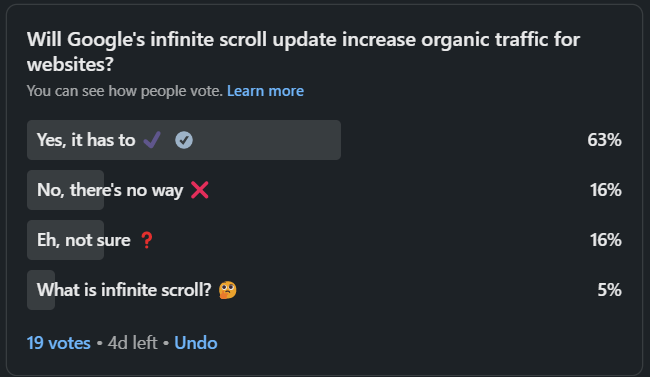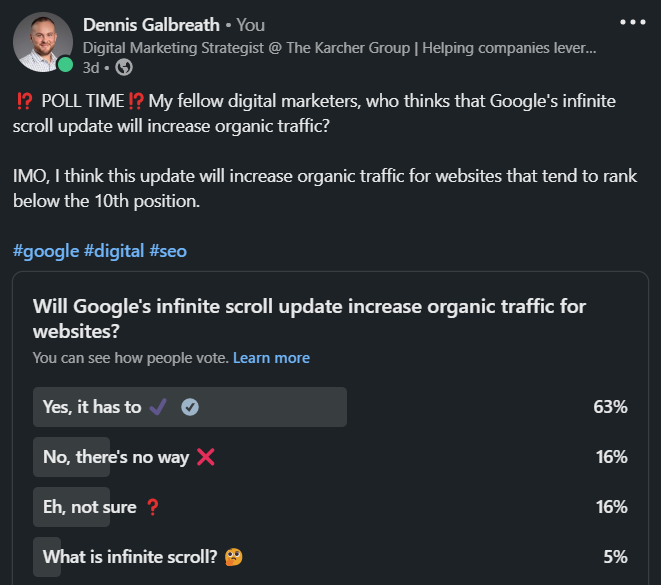If you’re a digital marketing client of TKG, you may have heard me mention Google’s recent updates to their search engine’s algorithm. If that is the case, you probably heard some frustration in my voice that came with it. As a digital marketing agency, it is our job to stay up to date with the most recent changes and ranking factors for search engines. It may seem surprising, but we actually care about these seemingly nerdy attributes because they help us get your website to the top of Google. But you may ask yourself from time to time why should I care about Google’s algorithm changes or why should I care as a business owner? Well, you’re in luck; below we have compiled a high-level list of all the things you need to know when it comes to Google’s recent updates to their search engine and ranking factors. Along with that, we have provided several tips that go with each item.
#1: No more “first page of google”
If you can spell SEO, you probably know that getting on the first page of Google is important – and we would usually agree with you . . . until Google got rid of pages. Google has introduced a change that may impact your paid and organic traffic. The change removes the option to toggle between “pages” on Google. Previously, a SERP (search engine results page) would only show 10 rankings at a time. Usually, the top 1-5 rankings would be advertisements from Google Search Ads. However, Google has recently removed the ability to toggle between pages and has introduced what they are calling infinite scroll. This concept now allows users to continuously scroll down past the first 10 ranks and will auto-populate rankings as one scrolls and scrolls. This concept is quite simple, but the results are yet to be shown. A few theories we have toyed with are below:
- This will increase organic traffic because there will be more eyeballs on websites that rank past the 10th slot of Google. We are still unsure how this will pan out, but we sure are keeping our eyes on it.
- It will have more visibility for the second set of ads. As you know, most decisions Google makes drive its revenue. Now that users can continuously scroll, there is now a second set of advertisements that will show as you scroll past the first 10 ranks.
- It does absolutely nothing: this theory is somewhat scary because it shows that people are getting the information they need from the top of Google – rather than your website. For example, go to Google and search “How long does it take to bake a chicken breast at 400?” As you can see, you can get your result directly from Google in a “rich snippet.” That brings us to our next point. . .
To see what our fellow marketers thought about this change, I created a poll on LinkedIn and got some interesting results on how professionals see this impacting traffic.
#2: People are getting their information directly from Google
As you saw in our previous example, thousands of instances allow users to get the answer they need right at the top of Google. While this sounds great and improves UX (user experience) for users of Google, the downside is that people may be less likely to click on a website if they instantaneously get their answer from Google. But on the bright side . . . Google will continuously prioritize your domain for other rankings if you are optimizing for their algorithm. So, what should you do?
- Produce content that is written in a Q&A format.
- Use your FAQ page as a resource for new blog ideas.
- Ask your customers what they search for in Google when trying to solve a problem in your industry.
#3: Freshening old content is more important than ever
If you are an SEO client of TKG, you have more than likely seen us optimize a page that was written in the past. We get questions frequently like “why should we optimize old content,” or “can we optimize something more recent.” Those are 100% fair questions! The reason why we optimize old content that is several months or even years old, is because Google prioritizes content that is fresh and updated frequently. If the subject matter of your business is timely and not evergreen, that makes it even more important that your content is up to date. Not only does optimizing your content help, but updating it with any new or relevant facts is extremely important. Google is smarter than you think – and relevance is key when it comes to ranking. Here are some helpful tips to update the content on your website:
- Optimize pages that previously had a lot of organic traffic but have recently dipped.
- Re-write old content and re-publish it as a new page.
- Reach out to TKG to optimize or re-write a blog or page that is no longer up-to-date.
#4 Backlinks matter . . . again!
Backlinking is an off-page SEO factor that is climbing the mountain when it comes to significance. In fact, several industry-leading SEO companies like SEMRush and Ahrefs have announced that it is the most important ranking factor when it comes to SEO and Google. So, what is backlinking? Backlinking is literally any time your website is linked on another website. There are several things that go into that like relevance, timeliness, and authority, but in short: the more backlinks the better. Here are a few ideas on how to get more backlinks:
- Competitor research: see what backlinks your competitors get, and create better content in hopes that your website will be linked as opposed to your competitors.
- Create linkable assets for other websites to use: this could be whitepapers, case studies, infographics, etc.
- Testimonials on other websites: this is one of the easiest ways to get backlinks. Reach out to companies that you are a client of and tell them you would be willing to provide a testimonial in the hope that it would be featured on their websites.
- Business associations and directories: make sure you are listed on your city’s chamber of commerce website. Along with that, if your business is a part of any associations, make sure you reach out to get listed on their website with a link to yours.
- Social media: while some platforms do not allow for links in posts (such as Instagram), linking on social media is an acceptable and easy way to get backlinks. Whether it be on your social media, or outside companies' pages, the more the merrier.
How is your website?
If you're not sure how your site stacks up against Google’s Algorithm, shoot me a message here or on LinkedIn. I'll be happy to take a look and provide actionable recommendations.




